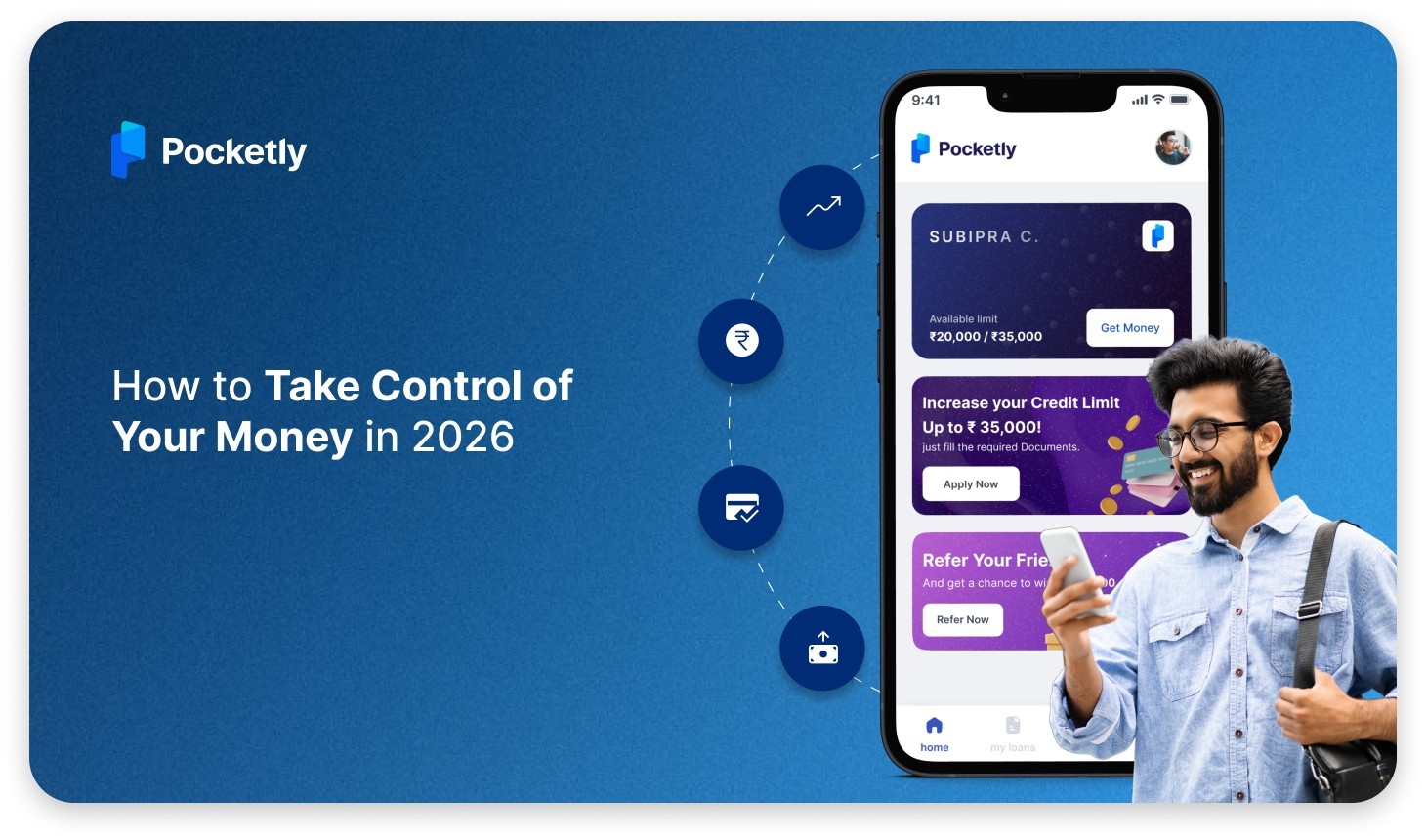
When you think about your money in 2025, you’ll likely notice a big difference, especially since you’ll be using your phone for almost everything. It could be paying bills to checking your bank balance, and discovering new apps offering faster loans, smarter savings, and better ways to invest.
In the past, banks and financial companies moved slowly. But now, they’re racing to keep up with technology and your needs. Digital banks are gaining popularity, and by 2025, India’s digital bank market is expected to reach US$25.58 billion (₹2,15,868 crore).
This shift isn’t just about new technology. It’s about making finance work better for you. Companies are using artificial intelligence (AI) to help you manage money, detect fraud, and even offer personalized advice in real time.
In this blog, we’ll take a closer look at the major financial services trends shaping 2025 and discover how you can take advantage of new opportunities.
Recent Trends In Financial Services
The financial sector in 2025 is experiencing a rapid digital transformation. New technologies, shifting customer needs, and fresh business models are transforming how you access and manage money. From digital loans that arrive in minutes to smarter ways of investing and saving, these trends are making finance more accessible and personal.
Embedded Finance
Have you ever booked a ride and paid without opening your wallet? That’s embedded finance. Financial services integrated directly into everyday apps. Embedded finance allows platforms like e-commerce, ride-hailing, and travel apps to offer financial tools such as payments, lending, insurance, and investments.
For example, UPI integration in ride-hailing apps like Ola or e-commerce platforms like Amazon allows instant, cashless transactions. MakeMyTrip offers travel insurance during ticket bookings, and e-commerce sites like Amazon provide product insurance at checkout. This makes insurance more accessible and relevant to customers in the moment.
Embedded finance simplifies the user experience and increases access to financial products, particularly for underserved and rural populations.
- Buy Now, Pay Later (BNPL)
One popular embedded finance option is Buy Now, Pay Later (BNPL). Apps like LazyPay and Simpl let users make purchases and pay in installments. E-commerce giants like Amazon and Flipkart also offer merchant loans based on transaction data.
Retailers benefit too: BNPL options can boost sales by 20-30%, making large purchases more manageable. Travel companies are embedding multi-currency wallets, enabling customers to pay in their local currency, whether INR or euros, without worrying about exchange rates. The result? Customers stay loyal because the process is simple, and brands see profits from seamless upsells.
The takeaway? Customers now expect tailored financial experiences. Banks that act as lifestyle partners, predicting needs and minimizing friction, will win customer loyalty. Mastercard’s Start Path program, for example, helps fintechs embed payments anywhere — from healthcare apps to grocery stores.
Artificial Intelligence (AI) and Machine Learning (ML)
As the financial industry evolves, one of the biggest changes in 2025 is the impact of artificial intelligence (AI) and machine learning (ML). These technologies are no longer just futuristic ideas; they’re actively shaping how banks and lenders protect your money, manage risks, and serve you as a customer.
- AI for Fraud Prevention
Banks are using AI to fight fraud. For instance, AI-powered platforms analyze large numbers of transactions instantly, detecting patterns that may signal fraudulent activity. Hence, these models can quickly flag unusual transactions, both nationally and overseas.
By learning from past fraud cases, AI becomes more effective with each transaction. ICICI Bank, for example, uses AI-driven systems to instantly detect and block fraudulent credit card transactions, protecting your money without you even noticing.
- AI-Powered Chatbots
Ever gotten stuck in a long chatbot loop? That’s changing. Now, AI-powered chatbots like SBI’s SIA or Axis Bank’s Axis Aha! can quickly answer questions, help you open accounts, or guide you through loan applications, all within seconds. These bots are available 24/7, making banking more convenient. With this shift, banks are rushing to offer this service — no one wants to be on hold for 20 minutes anymore.
- Regulatory Technology (Regtech)
AI is playing a key role in enhancing anti-money laundering (AML) systems, making it easier to detect suspicious transactions. By using machine learning (ML) algorithms, neural networks, anomaly detection methods, and economic impact assessments, AI is proving effective in reducing financial crimes, including in private military companies.
AI combines both supervised and unsupervised learning techniques to create models that identify money laundering patterns. These systems are outperforming traditional rule-based methods.
- Personalized Financial Services
Today’s financial services are all about personalization. Lenders use AI and data to tailor products to your specific needs, whether you’re building your credit score or managing your monthly expenses. For example, Pocketly offers flexible loan options where you can choose the loan amount and repayment plan that fits your lifestyle, giving you better control over your finances.
Personalized banking is just the beginning. Imagine entire financial ecosystems where money moves seamlessly between apps, stores, and services without the need for clunky logins or cluttered dashboards. This is what fintechs and neobanks are creating, leaving traditional banks racing to partner up or risk becoming obsolete.
Digital Evolution and Neo-Banks
The Unified Payments Interface (UPI) has transformed digital payments in India, with transactions reaching ₹21.48 trillion in February 2025, a 33% year-on-year increase. Mobile wallets like Paytm, PhonePe, and Google Pay, along with QR code payments, have become integral to everyday transactions, from retail shopping to peer-to-peer transfers.
The integration of prepaid payment instruments (PPIs) and digital wallets via UPI has expanded access to digital payments in rural and semi-urban areas, promoting financial inclusion. Government and RBI initiatives continue to drive innovation, security, and the commercial viability of digital payments, while tackling challenges such as regulatory compliance and fraud prevention.
- Neo-Banks: The Digital-Only Revolution
Neo-banks are digital-only banking platforms that operate without physical branches, offering seamless, branchless banking experiences through mobile and web apps. In India, neo-banks don’t hold independent banking licenses. Instead, they partner with regulated banks and NBFCs (Non-Banking Financial Companies) to provide services like account opening, payments, lending, prepaid cards, insurance, and business management tools.
These platforms use advanced technology and artificial intelligence to deliver personalized, low-cost, and transparent services. Features like spending insights, automated accounting, and tax filing make managing finances easier and more efficient.
Neo-banks make account setup quick and easy, offering access to a variety of trading markets, including cryptocurrencies and stocks. They’re like financial Swiss Army knives, packed with tools to help you manage your money effortlessly!
Examples like Freo, India’s first credit-led neobank, offer flexible loans (MoneyTap), a credit/EMI card (Freo Card), buy-now-pay-later options (Freo Pay), and digital utilities. Jupiter and Fi Money, partnered with Federal Bank, also provide a smooth digital banking experience.
- Collaboration of Fintechs and Neobanks
Fintechs and neo-banks are not replacing traditional banking; instead, they are pushing it to evolve. Banks that embrace the "platform" model, like AU Small Finance Bank’s collaborations with fintechs in India, will thrive. Banks that cling to outdated systems, however, will see customers shift to those offering seamless, effortless finance solutions. The future isn’t about “banks vs. fintechs” — it’s about “banks and fintechs” working together to build the future of finance.
Blockchain and Decentralized Finance (DeFi)
Blockchain and decentralized finance (DeFi) are creating a major shift in India’s financial landscape. Blockchain technology is enabling secure payments and smart contracts — self-executing agreements that automatically complete transactions when predefined conditions are met.
In India, these smart contracts are gaining popularity because they align with the Indian Contract Act, making them legally valid. This allows businesses and individuals to automate agreements without relying on lengthy paperwork, speeding up processes and reducing errors.
New solutions, such as cross-chain bridges and Layer 2 scaling, are also helping users transfer assets smoothly between different blockchains.
- The Rise of DeFi
On the DeFi front, India is witnessing a rapid growth of platforms where people can lend, borrow, and trade directly with one another, without the need for traditional banks. This peer-to-peer approach is a game-changer, providing access to credit for many who might not qualify through conventional banking channels.
DeFi apps use smart contracts to ensure secure and transparent transactions. For example, users can lend their crypto assets to earn interest or borrow funds by providing collateral. These transactions are made possible through decentralized apps that are accessible to everyone.
- India's Growing DeFi Ecosystem
Several Indian startups are jumping into the DeFi space, building platforms tailored to local needs while connecting with global networks. Platforms like HollaEx and mySwap enable Indian users to participate in decentralized trading and lending.
At the same time, popular global DeFi platforms like Aave and Uniswap are widely used in India, showing how the country is integrating into the broader decentralized finance ecosystem. Looking to the future, blockchain and DeFi in India are set to grow even further.
As regulations become clearer and technology improves, more industries will adopt blockchain for enhanced security and efficiency. DeFi platforms will continue to expand, offering innovative financial services that combine the best of traditional banking and decentralized systems.
This growth means more people in India will have safer and easier access to financial tools, helping drive financial inclusion and contributing to economic growth.
Sustainability and Green Finance
Sustainability and green finance focus on incorporating environmental, social, and governance (ESG) factors into financial decision-making. The Indian Banks' Association (IBA) has committed to developing an ESG framework, integrating climate risk into credit assessments, and promoting green financing initiatives.
In addition, 79% of the top 100 companies in India now publish standalone ESG reports, reflecting a growing trend toward transparency and accountability in ESG practices.
- Green Finance in Action
Want a mortgage that helps plant forests? Or an ETF that funds wind farms? That’s green finance at work. For instance, the State Bank of India (SBI) launched its Green Bond Framework in 2021, aiming to fund projects that reduce carbon emissions and improve energy efficiency.
ICICI Bank is also playing its part by offering green loans to businesses involved in renewable energy projects, waste management, and energy efficiency. By 2024, ICICI’s sustainable financing portfolio had reached over ₹68,000 crore, with a large portion allocated to renewable energy.
- Global Initiatives Supporting Green Finance
The Asian Development Bank’s (ADB) recent $500 million Solar Rooftop Investment Program focuses on residential solar systems under India’s Surya Ghar scheme. This funding, channeled through banks like SBI and NABARD, provides developers and homeowners with low-interest loans to install solar panels.
Additionally, ADB’s $250 million loan for Rajasthan’s solar projects aligns with India’s larger push for utility-scale renewables. ADB’s solar initiatives, supported by the World Bank’s expertise, are not just about clean energy—they represent a blueprint for integrating finance, policy, and technology to turn climate goals into tangible outcomes.
Banks that view ESG as a simple checkbox task will struggle, while those that embed it into their risk models will be better positioned to face future challenges.
Strengthening Cybersecurity
As AI and automation make banking and lending more efficient, there’s another crucial side to this digital growth: ensuring the safety of your money and personal data. While financial services become more connected and convenient, they also face new risks. Cybersecurity and data privacy are now central to maintaining trust in the financial sector.
You might feel a small concern every time you use a digital lending app or make an online payment: Is my data safe? This worry is valid, especially in India, where digital transactions have surged in recent years.
- The Growing Threat
According to a report by CERT-In, India experienced over 13.9 lakh (1.3 million) cybersecurity incidents in 2022 alone, with the numbers continuing to rise as more people turn to digital services.
In response, banks and fintech companies are investing heavily in advanced cybersecurity solutions like AI-driven threat detection and blockchain-based security protocols to protect sensitive data from hackers.
- Proactive Measures to Ensure Safety
The continuous threat of cybercrime is prompting financial institutions to adopt proactive measures, not just to comply with regulations but to protect their reputation and maintain customer trust.
As data breaches make headlines, customers are increasingly concerned about how their personal and financial information is handled. For companies like Paytm, this means going beyond firewalls to prove compliance with data security standards.
After the RBI’s strict audits of fintech companies, firms have proactively adopted frameworks similar to NIST (National Institute of Standards and Technology) to encrypt data, even for routine tasks like UPI payments. Meanwhile, Tata Consultancy Services (TCS) trains employees using AI simulations that mimic phishing scams, turning staff into the first line of defense against cyber threats.
As the importance of cybersecurity, data privacy, and trust continues to grow, these areas will shape the future of financial services. The ongoing evolution of digital security is essential for protecting both financial institutions and their customers.
Alternative Lending Platforms
Alternative lending platforms are revolutionizing how individuals and small businesses in India borrow money. Instead of turning to traditional banks, many are now using digital platforms that offer faster and easier loans. These platforms include peer-to-peer (P2P) lending sites, digital lending apps, and marketplace lenders, which help those who may not have a strong credit history or the typical documents banks require.
- Peer-to-Peer Lending
One popular trend is peer-to-peer lending. Platforms like i2i Funding, Lendbox, Finzy, and IndiaP2P connect borrowers directly with individual investors. This setup allows for quicker loan approvals and often offers better interest rates. For example, Pocketly, a digital lending platform, provides personal loans starting at just 2% interest per month, all through a completely digital process, eliminating the need to visit a bank or handle tons of paperwork.
- The Role of Technology
Technology plays a major role in these platforms. Many use artificial intelligence (AI) to assess a borrower’s creditworthiness. Instead of relying solely on traditional credit scores, these platforms consider additional data, such as utility bills, online activity, or even social media presence. This allows more people, especially those without formal credit histories, to access credit.
- Support from the Reserve Bank of India
The Reserve Bank of India (RBI) is also backing the growth of alternative lending. They introduced the Unified Lending Interface (ULI), which functions like the UPI payment system but for loans. ULI speeds up loan approvals and makes it easier for small businesses and rural borrowers to access credit. It also gives borrowers greater control over their data, which is a significant advantage.
- Digital Wallet Companies Entering Lending
Even digital wallet companies are entering the lending space, offering small loans to shop owners and merchants based on their digital transaction history. This is particularly beneficial for small retailers, enabling them to get quick, tailored loans that meet their specific needs.
Convenience is now non-negotiable. You expect to handle all your banking needs from your phone, and fintechs are delivering on that promise. With platforms like Pocketly’s simple online application process, you can apply for a loan anytime, anywhere, and get funds transferred directly to your bank account in minutes.
Why Pocketly Stands Out in India’s Digital Lending Space
As you can see, trust is now the foundation of every financial decision you make online. With so much of your personal and financial data moving through digital channels, you need solutions that are not only fast and convenient but also secure and transparent. This is especially true if you’re a student or a young professional in India, where managing unexpected expenses or month-end cash crunches is a common challenge.
That’s exactly where Pocketly comes in. Pocketly is designed with your needs in mind, offering a smart and simple way to access short-term loans without the usual hurdles of traditional banks. Unlike many lenders that require collateral or long credit histories, Pocketly makes borrowing possible for you even if you’re just starting out.
- Pocketly offers instant loan approvals and fast disbursals directly into your bank account, often within minutes. This speed is crucial when you face unexpected expenses or month-end cash crunches.
- Unlike many traditional lenders, Pocketly doesn’t ask for collateral. This makes it easier for students, young professionals, and self-employed individuals to access credit without risking assets.
- Whether you need a small amount like ₹1,000 or up to ₹25,000, Pocketly provides options tailored to your needs, helping you manage both minor and larger expenses comfortably.
- Pocketly is upfront about its charges. Interest rates start as low as 2% per month, and processing fees range from 1% to 8%, with no hidden costs. This transparency builds trust and helps you plan repayments better.
- You can apply for a loan completely online with minimal KYC requirements. No physical paperwork means less hassle and faster processing.
- Pocketly follows RBI guidelines strictly and partners with trusted NBFCs to ensure your data and transactions are secure, giving you peace of mind.
- Pocketly understands the unique challenges faced by students and young professionals in India, such as limited credit history and irregular income. Its products are crafted to address these realities.
If you’re looking for a smarter way to handle unexpected expenses, Pocketly is here to help you move forward with confidence.
Conclusion
The financial world is changing fast, and 2025 is proving to be a pivotal year. From AI-powered fraud detection to smarter risk management, from stronger cybersecurity to personalised customer experiences, these trends are reshaping how you manage your money. They are making financial services faster, safer, and more accessible, especially for young Indians like you who need quick, reliable solutions.
Digital lending platforms like Pocketly are leading this change by offering simple, transparent loans designed with your needs in mind. Whether you’re a student trying to build your credit or a young professional facing unexpected expenses, Pocketly’s quick approvals, flexible loan amounts, and secure processes can help you stay in control without the usual stress.
If you’re ready to handle your financial needs confidently and without hassle, don’t wait. Download the Pocketly app today and experience a smarter way to borrow. Your financial independence is just a few taps away!
FAQs
- What are some current financial trends in India?
Some key trends include the rise of digital lending platforms, more young people using credit, the popularity of UPI and mobile wallets, and a growing focus on financial literacy. Many young Indians now prefer quick, hassle-free loans from apps like Pocketly instead of traditional banks.
- How can I use financial trends to my advantage?
Stay updated on new tools and apps that help you save time and money. For example, using digital lending apps can help you get instant loans for emergencies. Learning about credit scores and responsible borrowing can also improve your financial health.
- Is it safe to use digital lending platforms?
Yes, as long as you choose trusted platforms like Pocketly that are transparent about their terms, interest rates, and fees. Always check if the app is registered and read user reviews before sharing your details.















